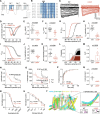Functional characterization of a novel de novo CACNA1C pathogenic variant in a patient with neurodevelopmental disorder
- PMID: 40133997
- PMCID: PMC11934713
- DOI: 10.1186/s13041-025-01195-w
Functional characterization of a novel de novo CACNA1C pathogenic variant in a patient with neurodevelopmental disorder
Abstract
Mutations in CACNA1C, the gene encoding Cav1.2 voltage-gated calcium channels, are associated with a spectrum of disorders, including Timothy syndrome and other neurodevelopmental and cardiac conditions. In this study, we report a child with a de novo heterozygous missense variant (c.1973T > C; L658P) in CACNA1C, presenting with refractory epilepsy, global developmental delay, hypotonia, and multiple systemic abnormalities, but without overt cardiac dysfunction. Electrophysiological analysis of the recombinant Cav1.2 L658P variant revealed profound gating alterations, most notably a significant hyperpolarizing shift in the voltage dependence of activation and inactivation. Additionally, molecular modeling suggested that the L658P mutation disrupts interactions within the IIS5 transmembrane segment, reducing the energy barrier for state transitions and facilitating channel opening at more negative voltages. These findings establish L658P as a pathogenic CACNA1C variant primarily associated with severe neurological dysfunction and expands the phenotypic spectrum of CACNA1C-related disorders.
Keywords: CACNA1C; Calcium channel; Cav1.2; Channelopathies; Electrophysiology; L658P.
© 2025. The Author(s).
Conflict of interest statement
Declarations. Ethics approval and consent to participate: Not applicable. Consent for publication: Not applicable. Competing interests: The authors declare no competing interests.
Figures

References
-
- Splawski I, Timothy KW, Sharpe LM, Decher N, Kumar P, Bloise R, et al. Ca(V)1.2 calcium channel dysfunction causes a multisystem disorder including arrhythmia and autism. Cell. 2004;119(1):19–31. - PubMed
Publication types
MeSH terms
Substances
Grants and funding
LinkOut - more resources
Full Text Sources

